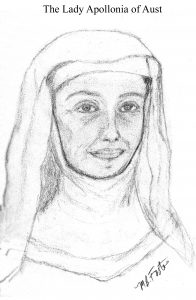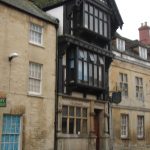 Effigy of the Cloven Hoof introduces modern readers to a new religious concept: that of a mature medieval woman becoming a vowess in her later years. The following paragraph from the story tells of Lady Apollonia’s announcement to her brother, Ferdinand, of her intentions. A vowess was a widow who had vowed chastity or devotion to a religious life while remaining in the world. The drawing above pictures Apollonia in the period of her life when she was a vowess.
Effigy of the Cloven Hoof introduces modern readers to a new religious concept: that of a mature medieval woman becoming a vowess in her later years. The following paragraph from the story tells of Lady Apollonia’s announcement to her brother, Ferdinand, of her intentions. A vowess was a widow who had vowed chastity or devotion to a religious life while remaining in the world. The drawing above pictures Apollonia in the period of her life when she was a vowess.
“It was in the year of 1395 that Lady Apollonia announced to her brother, Ferdinand, her intention to live celibate. She had, with the counsel of her chaplain and the Abbess of Lacock, decided to follow the rule of the devotio moderna, become a vowess, and give the rest of her life to a discipline of work, charity, and contemplation. “I can not renounce the world, Ferdinand,” she quietly confessed to him, “but I feel alienated by it.” The colours of mourning would continue to be her habit of dress and though never cloistered, she chose to spend her remaining years as a bride of Christ.”
Devotio Moderna or Modern Devotion is defined in the Glossary at the end of Effigy of the Cloven Hoof as a religious movement of the late Middle Ages, stressing meditation and emphasizing the inner life of the individual. Having been widowed three times and the mother of five sons, Lady Apollonia took vows both for chastity and for devotion to a religious life while being allowed to remain in the world.
As a vowess, the Lady, who had acquired considerable wealth and property from her deceased husbands, would be protected by the church. Hence, she pronounced her vows of chastity in the presence of the Bishop of Worcester and, in effect, became a bride of Christ. That act, recognized by the Church, offered her protection from any unwanted late in life marriage while allowing her to remain in charge pf her faithful affinity in Aust.
Lady Apollonia in her widowhood was enabled to continue to manage the affairs of the lands and businesses that she inherited from her husbands. These included the manor and lands at Colerene Leat, inherited from her first husband, Geoffrey Montacute; the various woollen businesses developed over the years by her second husband, Edward Aust, in Aust, Corsham, Exeter, and other places; and the businesses of furrier, pelterer, and others of her third husband, Richard Windemere, in Gloucester, Cirencester, Wiltshire and beyond. The building, shown above on the left, is in Cirencester on Dyer Street. It was my inspiration for Windemere House where Lady Apollonia was residing in Templar’s Prophecy.
Lady Apollonia of Aust became a very wealthy woman who was a well-educated and capable manager as well as a caring leader of her personal affinity. She was beloved by all those who served her and benefitted from her goodness, but at the same time, she would have been a desirable target for egregious male suitors if she had not been protected by the Church as a vowess.

